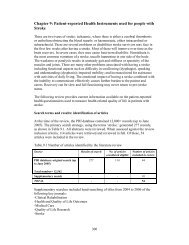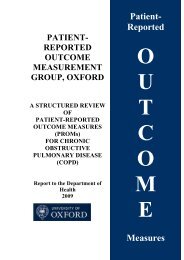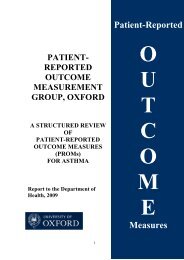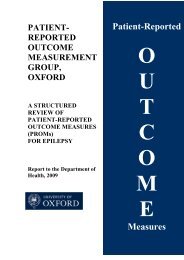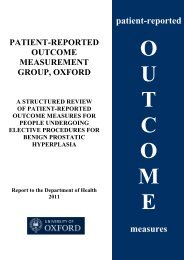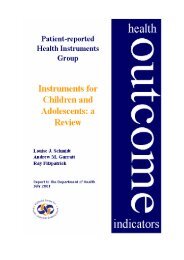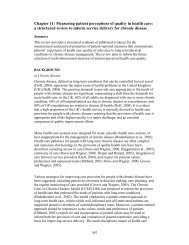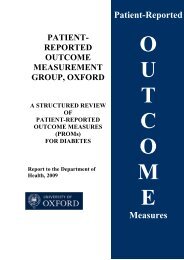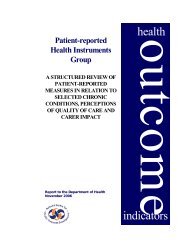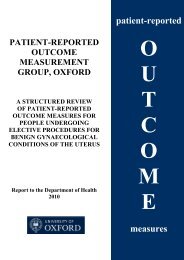2010 review - Patient-Reported Outcomes Measurement - University ...
2010 review - Patient-Reported Outcomes Measurement - University ...
2010 review - Patient-Reported Outcomes Measurement - University ...
Create successful ePaper yourself
Turn your PDF publications into a flip-book with our unique Google optimized e-Paper software.
The PF subscale discriminated between patient groups and detected within-group change in a<br />
study examining outcomes in patients with advanced CAD; patients undergoing CABG<br />
experienced significantly greater improvement at two years than those who did not receive<br />
surgery (Kandzari et al., 2001; MOSS study). All SF-36 domains except BP and MH<br />
discriminated between treatment groups at four months in a trial of interventional versus<br />
conservative treatment for patients with angina or NSTEMI (Kim et al., 2005, UK; RITA-3<br />
trial); however, these differences remained significant at one year in only four of eight<br />
dimensions (RP, SF, V, and GH) (Kim et al., 2005, UK). Similar results were reported in the<br />
COURAGE trial which compared the use of optimal medical therapy (OMT) alone and OMT<br />
with PCI support (Weintraub et al., 2008). SF-36 scores in five domains (PF, RP, V, BP, GH)<br />
showed an advantage of PCI over OMT alone up to three months; by 12 months, however, no<br />
advantage was apparent (Weintraub et al., 2008).<br />
The SF-36 scores discriminated patient groups by demographic characteristics in several<br />
studies. Five of eight SF-36 domains (PF, RF, SF, RE, MH) showed that Black patients had<br />
significantly worse outcomes than Whites at six months post-revascularisation (Kaul et al.,<br />
2005). All SF-36 domains except MH showed significant differences between age-groups in<br />
the study by Bradshaw et al. (2006), with younger respondents generally reporting higher<br />
HRQoL. Significant differences between men and women in SF-36 physical component<br />
scores (BP, GH, PF, RP) were found at three time-points in a study examining gender<br />
differences in patients’ experience of CABG surgery (Sawatzky & Naimark, 2009b). Lower<br />
PCS and MCS scores were significantly associated with mortality in older (≤65), but not<br />
younger, patients following CABG and/or valve surgery (p=0.01 for PCS and p=0.03 for<br />
MCS) (Ho et al., 2005).<br />
In a RCT assessing the QoL of individuals undergoing PTCA (Pocock et al., 2000, UK), the<br />
SF-36 discriminated between grades of disease severity, for both the control and the<br />
intervention group, in the PF, VT, and GH domains, with greater disease severity resulting in<br />
lower scores for each of these three dimensions. In a prospective study of post-CABG<br />
patients by Lindsay et al. (2000, UK), SF-36 detected different levels of health in individuals<br />
at a single point in time.<br />
The SF-36 also discriminated between patient sample and population norms in several<br />
studies. The study by Worcester et al. (2007) reported scores significantly lower than norms<br />
on all SF-36 subscales except GH at two, four, and 12 months. In the study by Hawkes et al.<br />
(2003), patient scores on all subscales were significantly lower than for age-matched<br />
population norms at baseline (p≤0.05); at six months, RP and BP subscales were significantly<br />
lower (p



